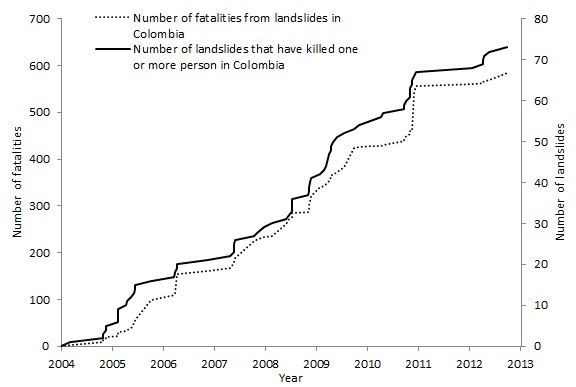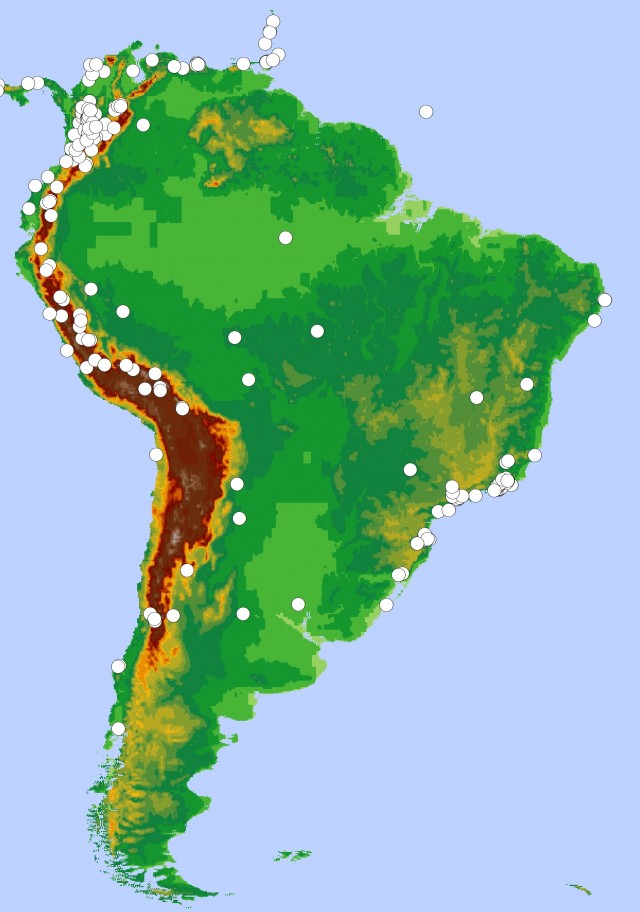16 November 2012
Losses from landslides in Colombia
Posted by Dave Petley
Colombia is a country with a serious landslide problem. The combination of mountainous terrain, active tectonics, occasional earthquakes, deep weathering and intense rainfall means that the level of hazard is high. Add to this a vulnerable population and rapid expansion of the infrastructure, and the results are inevitably that losses from landslides are high. In recent years I seem to have blogged about landslide events in Colombia on numerous occasions (for example here, here and here), and there have been some spectacular events caught on video.
This graph shows the cumulative level of landslide losses in Colombia since the start of 2004, based upon my fatal landslide database (a paper explaining and analysing the data from the database can be found here):
 The seasonal nature of losses from landslides is quite clear, as is the high rate of losses in the period 2007-2011. Note that rainfall patterns in Colombia are heavily affected by the El Niño – La Nina (ENSO) cycle, with the heaviest precipitation being associated with El Niño conditions. Current conditions are neutral in terms of ENSO at present, but the effects of the recent La Nina conditions are clear in the graph above when the previously steep trend flattened out.
The seasonal nature of losses from landslides is quite clear, as is the high rate of losses in the period 2007-2011. Note that rainfall patterns in Colombia are heavily affected by the El Niño – La Nina (ENSO) cycle, with the heaviest precipitation being associated with El Niño conditions. Current conditions are neutral in terms of ENSO at present, but the effects of the recent La Nina conditions are clear in the graph above when the previously steep trend flattened out.
The impact of landslides across Colombia compared with the rest of South America can be seen in the map below, which shows fatal landslides from 2004 to 2011. Each dot is a single landslide that killed one or more people; the background is a digital elevation model. The concentration in Colombia (in the northwest of the map) is clear:
 If we are to reduce the impact of landslides across South America then Colombia needs to be a priority country. Note also that western Colombia has high levels of seismic hazard – a large earthquake in this area would probably cause landsliding on a very large scale.
If we are to reduce the impact of landslides across South America then Colombia needs to be a priority country. Note also that western Colombia has high levels of seismic hazard – a large earthquake in this area would probably cause landsliding on a very large scale.


 Dave Petley is the Vice-Chancellor of the University of Hull in the United Kingdom. His blog provides commentary and analysis of landslide events occurring worldwide, including the landslides themselves, latest research, and conferences and meetings.
Dave Petley is the Vice-Chancellor of the University of Hull in the United Kingdom. His blog provides commentary and analysis of landslide events occurring worldwide, including the landslides themselves, latest research, and conferences and meetings.